Abstract
1. Nifedipine and DHM9 (carboxymethyl methyl 1,4-dihydro-2,6-dimethyl-4-(3-nitrophenyl)-3,5-pyridinedicarboxylate) were studied for their effects on arrhythmias resulting from regional myocardial ischaemia in conscious rats, and for their effects on left ventricular developed pressure in vitro. 2. Nifedipine possessed antiarrhythmic activity at a high dose of 10 mg kg-1 i.v., but not at 0.5 or 2 mg kg-1. Ventricular fibrillation (VF), tachycardia (VT), and ventricular premature beats (VPB) were all attenuated to a similar degree; nifedipine did not have a selectivity of action for high frequency arrhythmias. 3. Before coronary occlusion, the three doses of nifedipine reduced arterial blood pressure by a similar magnitude, indicating a similar (maximal) degree of systemic vasodilatation. The reductions in blood pressure were accompanied by reflex tachycardia. Heart rate and blood pressure did not correlate with the incidence or severity of arrhythmias. 4. DHM9 had no influence on arrhythmias, haemodynamic variables or the ECG, even at 20 mg kg-1 i.v. 5. Nifedipine concentration-dependently reduced contractility in perfused paced (5 Hz) rat ventricles in vitro. Raising the concentration of K+ in the perfusion fluid from 3 to 10 mequiv.l-1 increased the potency (-log10 EC50) of nifedipine up to four fold, and caused a significant depression in excitability. 6. DHM9 at up to 3 x 10(-5) M had no significant influence on ventricular contractility in vitro. 7. The results provided indirect evidence in support of the hypothesis that calcium antagonists inhibit ischaemia-induced arrhythmias by virtue of inhibition of the slow inward current (Isi) in the ischaemic ventricular myocardium.
Full text
PDF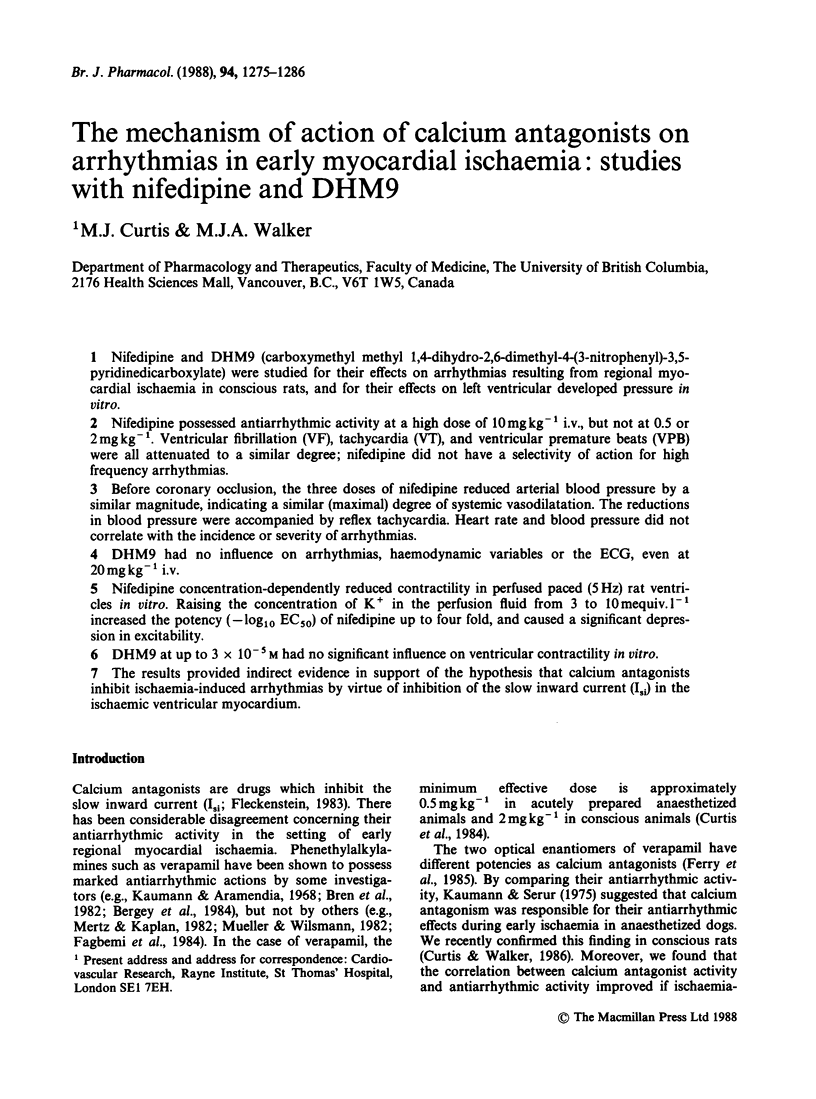

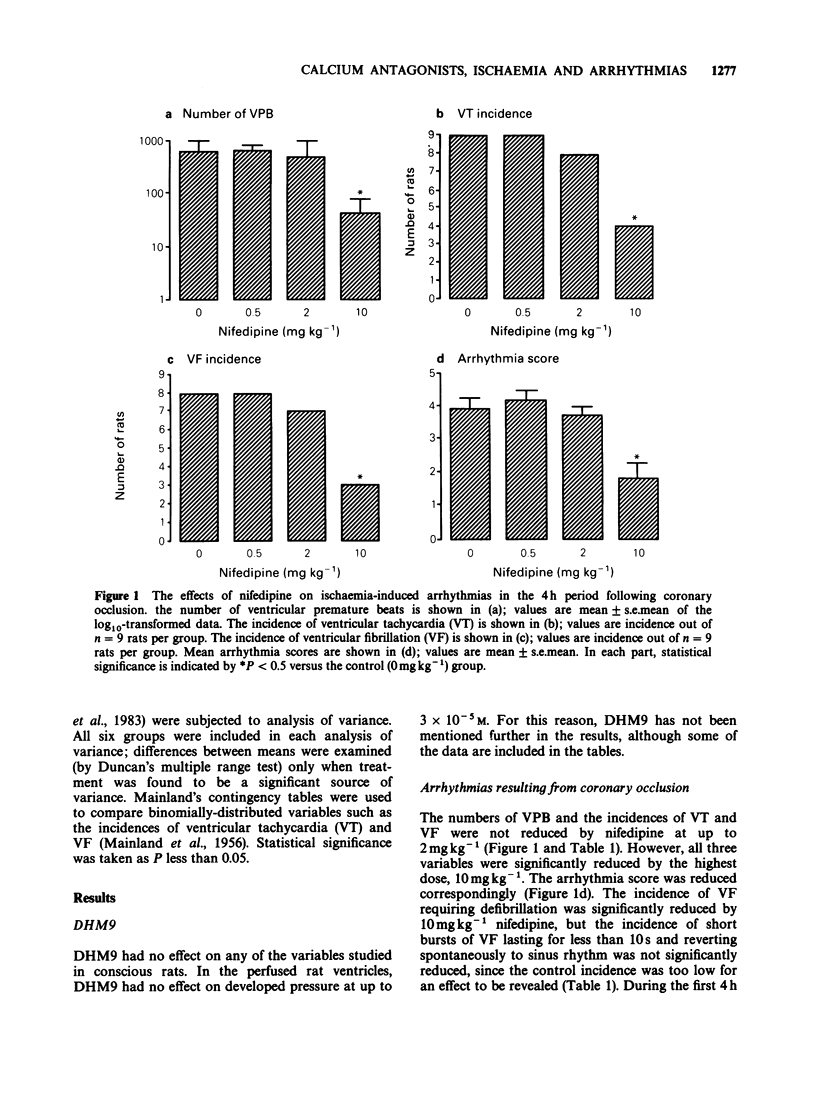
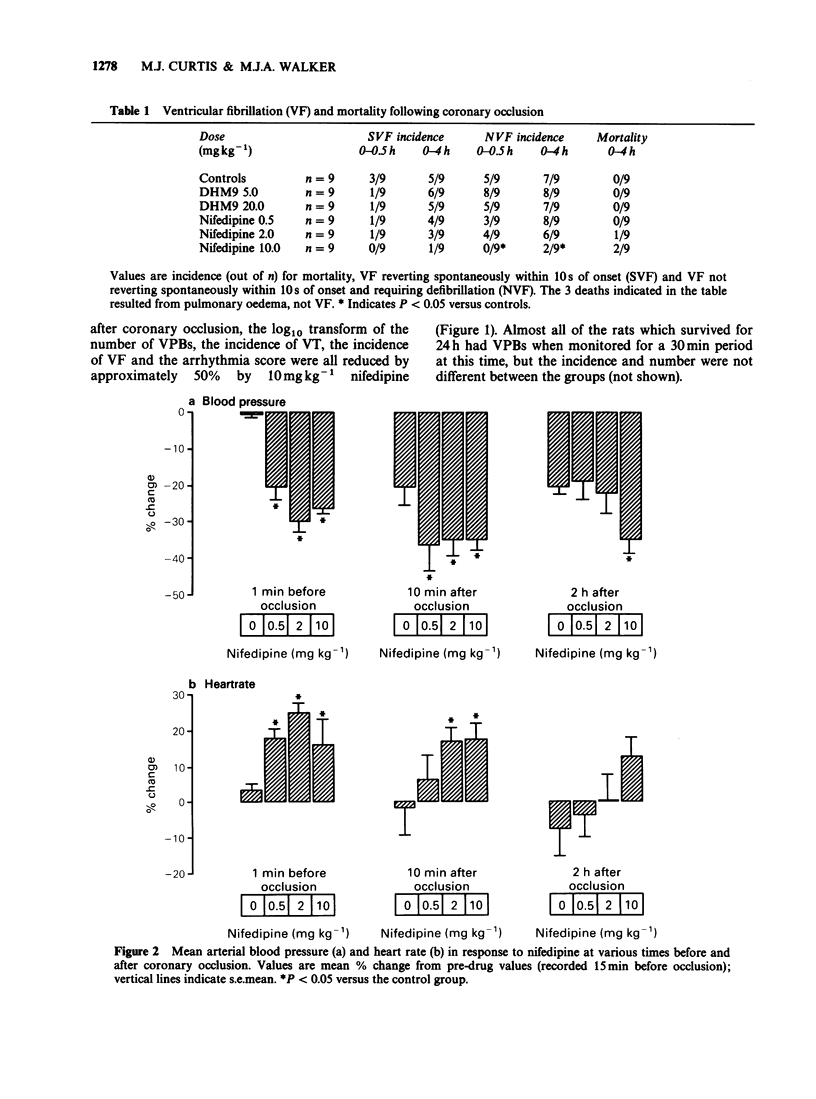

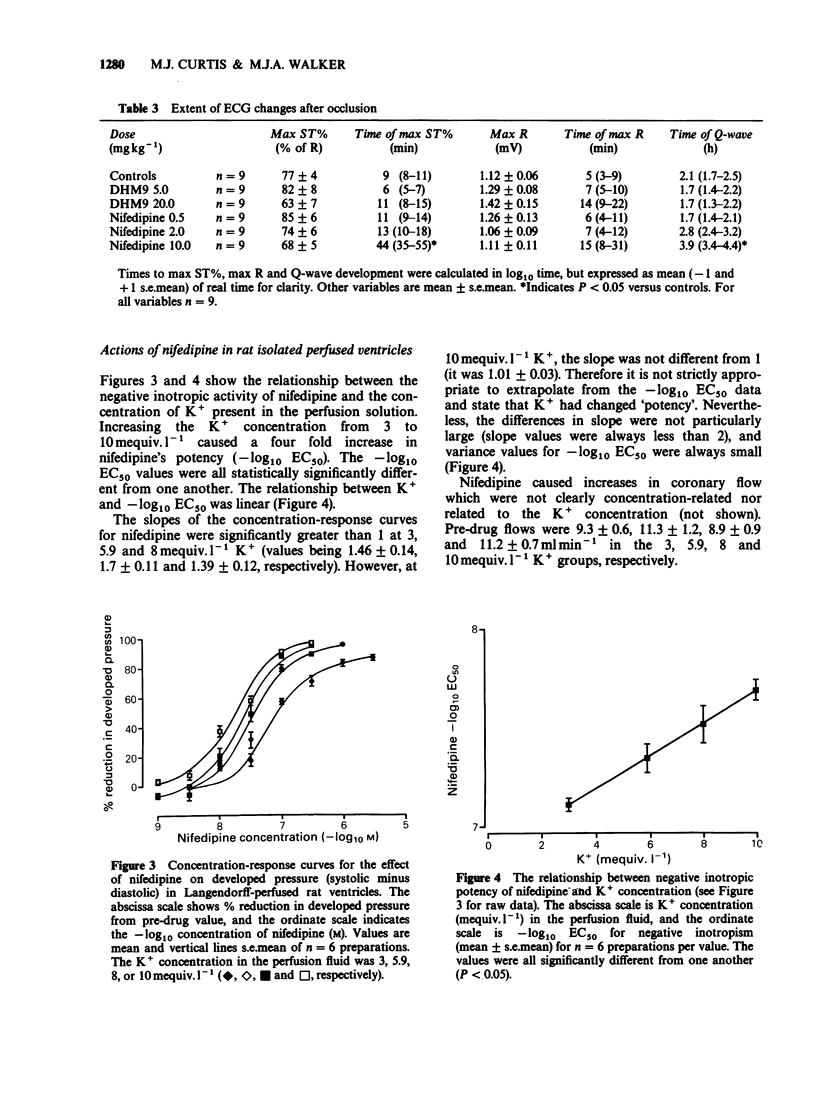
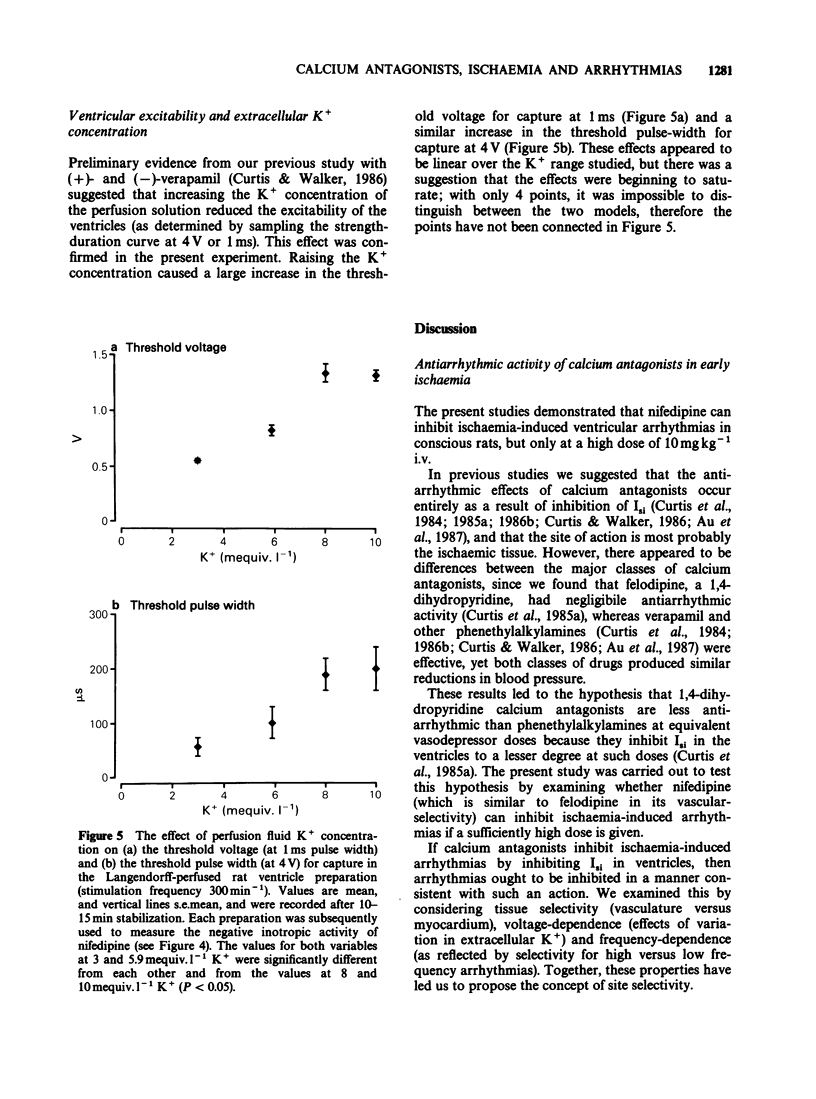
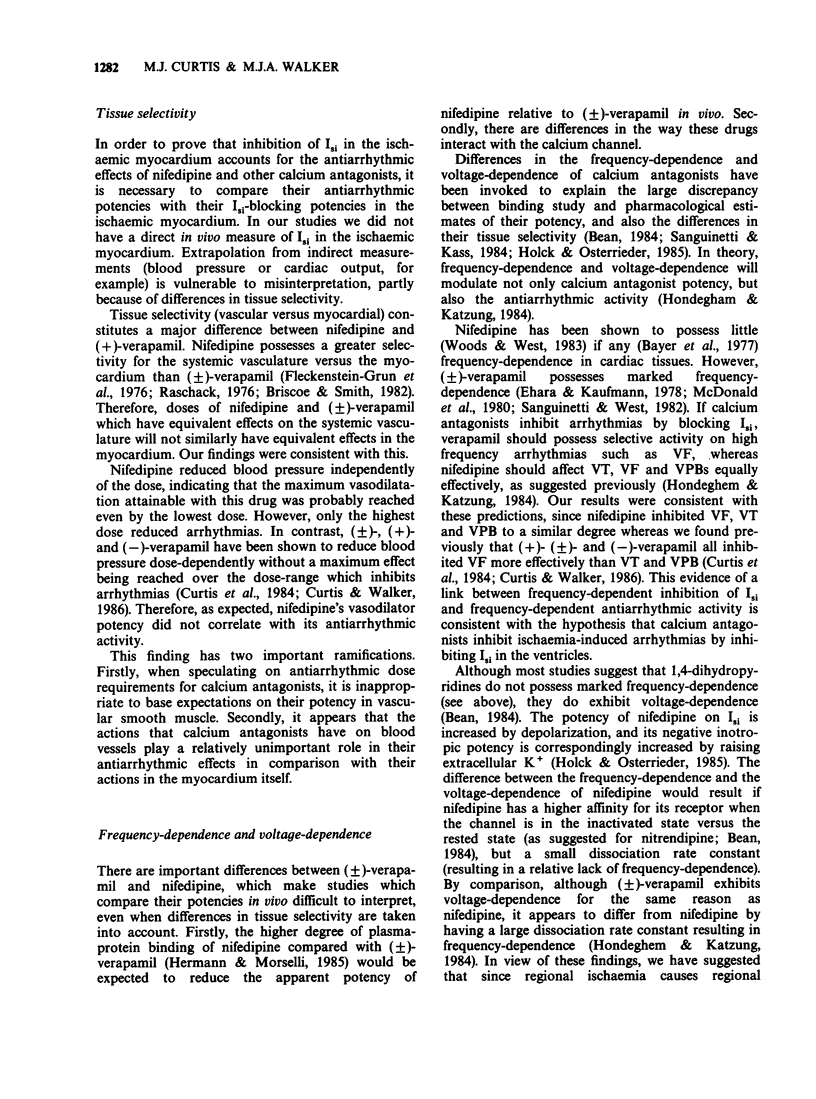


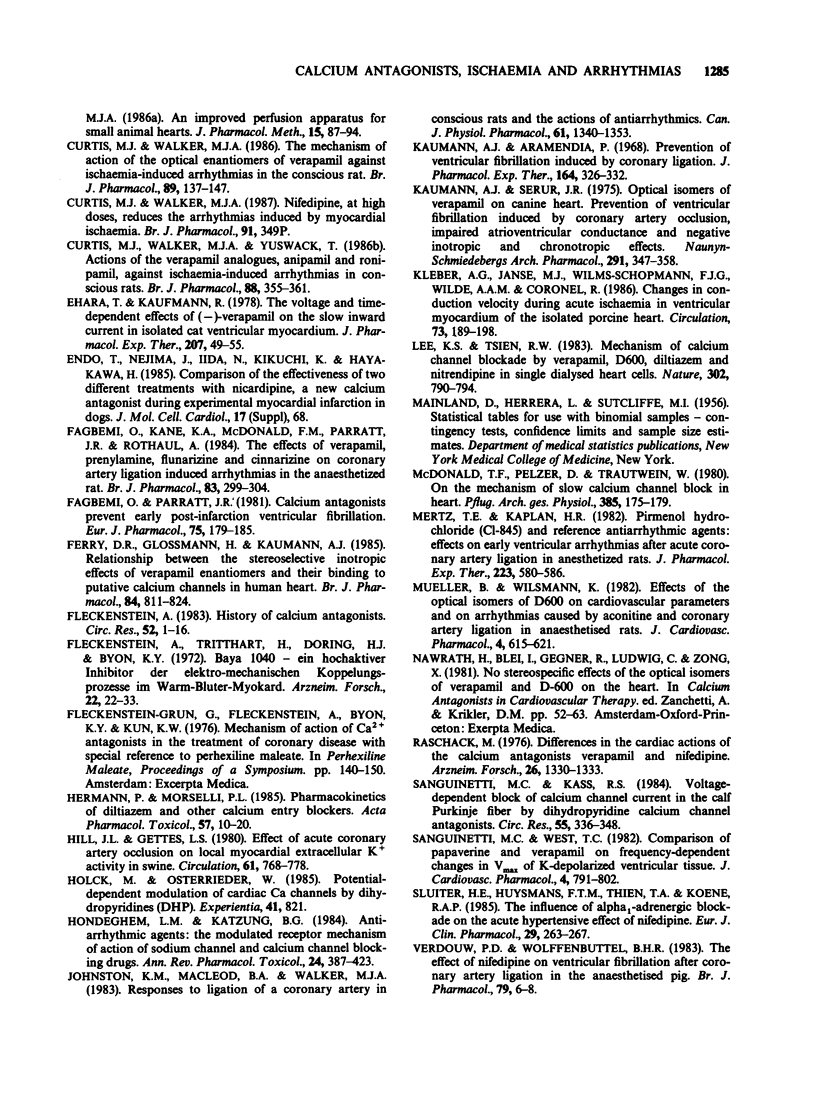
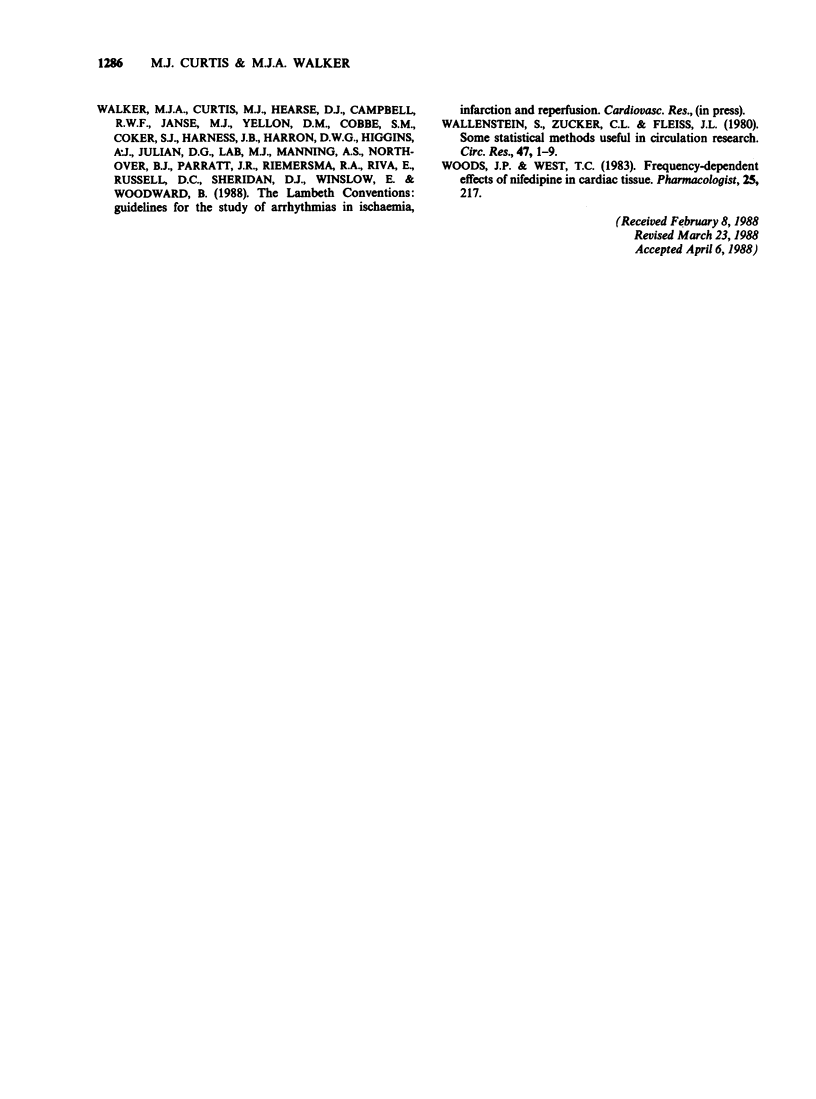
Selected References
These references are in PubMed. This may not be the complete list of references from this article.
- Au T. L., Collins G. A., Macleod B. A., Walker M. J. Effects of prostaglandin E2, propranolol and nitroglycerine with halothane, pethidine or pentobarbitone anaesthesia on arrhythmias and other responses to ligation of a coronary artery in rats. Br J Pharmacol. 1983 Aug;79(4):929–937. doi: 10.1111/j.1476-5381.1983.tb10538.x. [DOI] [PMC free article] [PubMed] [Google Scholar]
- Au T. L., Curtis M. J., Walker M. J. Effects of (-), (+/- ), and (+) verapamil on coronary occlusion-induced mortality and infarct size. J Cardiovasc Pharmacol. 1987 Sep;10(3):327–331. doi: 10.1097/00005344-198709000-00012. [DOI] [PubMed] [Google Scholar]
- Bayer R., Rodenkirchen R., Kaufmann R., Lee J. H., Hennekes R. The effects of nifedipine on contraction and monophasic action potential of isolated cat myocardium. Naunyn Schmiedebergs Arch Pharmacol. 1977 Dec;301(1):29–37. doi: 10.1007/BF00501261. [DOI] [PubMed] [Google Scholar]
- Bean B. P. Nitrendipine block of cardiac calcium channels: high-affinity binding to the inactivated state. Proc Natl Acad Sci U S A. 1984 Oct;81(20):6388–6392. doi: 10.1073/pnas.81.20.6388. [DOI] [PMC free article] [PubMed] [Google Scholar]
- Bergey J. L., Wendt R. L., Nocella K., McCallum J. D. Acute coronary artery occlusion-reperfusion arrhythmias in pigs: antiarrhythmic and antifibrillatory evaluation of verapamil, nifedipine, prenylamine and propranolol. Eur J Pharmacol. 1984 Jan 13;97(1-2):95–103. doi: 10.1016/0014-2999(84)90516-8. [DOI] [PubMed] [Google Scholar]
- Briscoe M. G., Smith H. J. Sensitivity of cat papillary muscles to verapamil and nifedipine: enhanced effect in acidosis. Cardiovasc Res. 1982 Apr;16(4):173–177. doi: 10.1093/cvr/16.4.173. [DOI] [PubMed] [Google Scholar]
- Coker S. J., Parratt J. R. Relationships between the severity of myocardial ischaemia, reperfusion-induced ventricular fibrillation, and the late administration of dazmegrel or nifedipine. J Cardiovasc Pharmacol. 1985 Mar-Apr;7(2):327–334. doi: 10.1097/00005344-198503000-00019. [DOI] [PubMed] [Google Scholar]
- Curtis M. J., Johnston K. M., Macleod B. A., Walker M. J. The actions of felodipine on arrhythmias and other responses to myocardial ischaemia in conscious rats. Eur J Pharmacol. 1985 Nov 5;117(2):169–178. doi: 10.1016/0014-2999(85)90601-6. [DOI] [PubMed] [Google Scholar]
- Curtis M. J., MacLeod B. A., Walker M. J. Antiarrhythmic actions of verapamil against ischaemic arrhythmias in the rat. Br J Pharmacol. 1984 Oct;83(2):373–385. doi: 10.1111/j.1476-5381.1984.tb16497.x. [DOI] [PMC free article] [PubMed] [Google Scholar]
- Curtis M. J., Macleod B. A., Walker M. J. Models for the study of arrhythmias in myocardial ischaemia and infarction: the use of the rat. J Mol Cell Cardiol. 1987 Apr;19(4):399–419. doi: 10.1016/s0022-2828(87)80585-0. [DOI] [PubMed] [Google Scholar]
- Curtis M. J., Walker M. J. The mechanism of action of the optical enantiomers of verapamil against ischaemia-induced arrhythmias in the conscious rat. Br J Pharmacol. 1986 Sep;89(1):137–147. doi: 10.1111/j.1476-5381.1986.tb11129.x. [DOI] [PMC free article] [PubMed] [Google Scholar]
- Curtis M. J., Walker M. J., Yuswack T. Actions of the verapamil analogues, anipamil and ronipamil, against ischaemia-induced arrhythmias in conscious rats. Br J Pharmacol. 1986 Jun;88(2):355–361. doi: 10.1111/j.1476-5381.1986.tb10211.x. [DOI] [PMC free article] [PubMed] [Google Scholar]
- Ehara T., Daufmann R. The voltage- and time-dependent effects of (-)-verapamil on the slow inward current in isolated cat ventricular myocardium. J Pharmacol Exp Ther. 1978 Oct;207(1):49–55. [PubMed] [Google Scholar]
- Fagbemi O., Kane K. A., McDonald F. M., Parratt J. R., Rothaul A. L. The effects of verapamil, prenylamine, flunarizine and cinnarizine on coronary artery occlusion-induced arrhythmias in anaesthetized rats. Br J Pharmacol. 1984 Sep;83(1):299–304. doi: 10.1111/j.1476-5381.1984.tb10146.x. [DOI] [PMC free article] [PubMed] [Google Scholar]
- Fagbemi O., Parratt J. R. Calcium antagonists prevent early post-infarction ventricular fibrillation. Eur J Pharmacol. 1981 Nov 5;75(4):179–185. doi: 10.1016/0014-2999(81)90543-4. [DOI] [PubMed] [Google Scholar]
- Ferry D. R., Glossmann H., Kaumann A. J. Relationship between the stereoselective negative inotropic effects of verapamil enantiomers and their binding to putative calcium channels in human heart. Br J Pharmacol. 1985 Apr;84(4):811–824. doi: 10.1111/j.1476-5381.1985.tb17375.x. [DOI] [PMC free article] [PubMed] [Google Scholar]
- Fleckenstein A. History of calcium antagonists. Circ Res. 1983 Feb;52(2 Pt 2):I3–16. [PubMed] [Google Scholar]
- Fleckenstein A., Tritthart H., Döring H. J., Byon K. Y. BAY a 1040--ein hochaktiver Ca -antagonistischer Inhibitor der elektro-mechanischen Koppelungsprozesse im Warmblüter-Myokard. Arzneimittelforschung. 1972 Jan;22(1):22–33. [PubMed] [Google Scholar]
- Hermann P., Morselli P. L. Pharmacokinetics of diltiazem and other calcium entry blockers. Acta Pharmacol Toxicol (Copenh) 1985;57 (Suppl 2):10–20. doi: 10.1111/j.1600-0773.1985.tb03570.x. [DOI] [PubMed] [Google Scholar]
- Hill J. L., Gettes L. S. Effect of acute coronary artery occlusion on local myocardial extracellular K+ activity in swine. Circulation. 1980 Apr;61(4):768–778. doi: 10.1161/01.cir.61.4.768. [DOI] [PubMed] [Google Scholar]
- Hondeghem L. M., Katzung B. G. Antiarrhythmic agents: the modulated receptor mechanism of action of sodium and calcium channel-blocking drugs. Annu Rev Pharmacol Toxicol. 1984;24:387–423. doi: 10.1146/annurev.pa.24.040184.002131. [DOI] [PubMed] [Google Scholar]
- Johnston K. M., MacLeod B. A., Walker M. J. Responses to ligation of a coronary artery in conscious rats and the actions of antiarrhythmics. Can J Physiol Pharmacol. 1983 Nov;61(11):1340–1353. doi: 10.1139/y83-193. [DOI] [PubMed] [Google Scholar]
- Kaumann A. J., Aramendía P. Prevention of ventricular fibrillation induced by coronary ligation. J Pharmacol Exp Ther. 1968 Dec;164(2):326–332. [PubMed] [Google Scholar]
- Kaumann A. J., Serur J. R. Optical isomers of verapamil on canine heart. Prevention of ventricular fibrillation induced by coronary artery occlusion, impaired atrioventricular conductance and negative inotropic and chronotropic effects. Naunyn Schmiedebergs Arch Pharmacol. 1975;291(4):347–358. doi: 10.1007/BF00501793. [DOI] [PubMed] [Google Scholar]
- Kléber A. G., Janse M. J., Wilms-Schopmann F. J., Wilde A. A., Coronel R. Changes in conduction velocity during acute ischemia in ventricular myocardium of the isolated porcine heart. Circulation. 1986 Jan;73(1):189–198. doi: 10.1161/01.cir.73.1.189. [DOI] [PubMed] [Google Scholar]
- Lee K. S., Tsien R. W. Mechanism of calcium channel blockade by verapamil, D600, diltiazem and nitrendipine in single dialysed heart cells. Nature. 1983 Apr 28;302(5911):790–794. doi: 10.1038/302790a0. [DOI] [PubMed] [Google Scholar]
- McDonald T. F., Pelzer D., Trautwein W. On the mechanism of slow calcium channel block in heart. Pflugers Arch. 1980 May;385(2):175–179. doi: 10.1007/BF00588699. [DOI] [PubMed] [Google Scholar]
- Mertz T. E., Kaplan H. R. Pirmenol hydrochloride (CI-845) and reference antiarrhythmic agents: effects on early ventricular arrhythmias after acute coronary artery ligation in anesthetized rats. J Pharmacol Exp Ther. 1982 Nov;223(2):580–586. [PubMed] [Google Scholar]
- Müller B., Wilsmann K. Effects of the optical isomers of D 600 on cardiovascular parameters and on arrhythmias caused by aconitine and coronary artery ligation in anesthetized rats. J Cardiovasc Pharmacol. 1982 Jul-Aug;4(4):615–621. doi: 10.1097/00005344-198207000-00013. [DOI] [PubMed] [Google Scholar]
- Raschack M. Differences in the cardiac actions of the calcium antagonists verapamil and nifedipine. Arzneimittelforschung. 1976;26(7):1330–1333. [PubMed] [Google Scholar]
- Sanguinetti M. C., Kass R. S. Voltage-dependent block of calcium channel current in the calf cardiac Purkinje fiber by dihydropyridine calcium channel antagonists. Circ Res. 1984 Sep;55(3):336–348. doi: 10.1161/01.res.55.3.336. [DOI] [PubMed] [Google Scholar]
- Sanguinetti M. C., West T. C. Comparison of papaverine and verapamil on frequency-dependent changes in Vmax of K-depolarized ventricular tissue. J Cardiovasc Pharmacol. 1982 Sep-Oct;4(5):791–802. doi: 10.1097/00005344-198209000-00015. [DOI] [PubMed] [Google Scholar]
- Sluiter H. E., Huysmans F. T., Thien T. A., Koene R. A. The influence of alpha 1-adrenergic blockade on the acute antihypertensive effect of nifedipine. Eur J Clin Pharmacol. 1985;29(3):263–267. doi: 10.1007/BF00544078. [DOI] [PubMed] [Google Scholar]
- Verdouw P. D., Wolffenbuttel B. H. The effect of felodipine on ventricular fibrillation after coronary artery ligation in the anaesthetized pig. Br J Pharmacol. 1983 May;79(1):6–8. doi: 10.1111/j.1476-5381.1983.tb10486.x. [DOI] [PMC free article] [PubMed] [Google Scholar]
- Wallenstein S., Zucker C. L., Fleiss J. L. Some statistical methods useful in circulation research. Circ Res. 1980 Jul;47(1):1–9. doi: 10.1161/01.res.47.1.1. [DOI] [PubMed] [Google Scholar]


